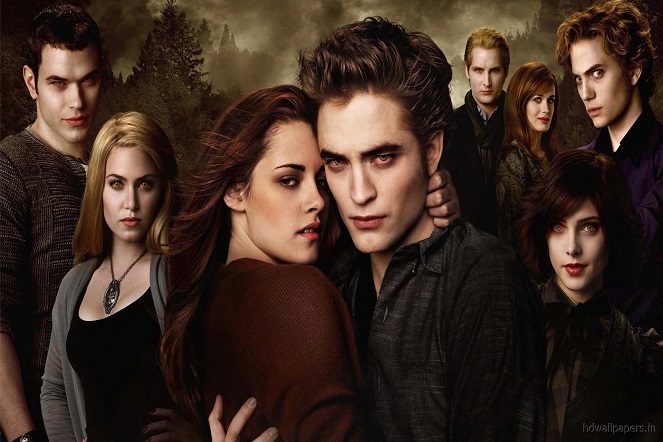Ten years ago, a pop culture phenomenon took place: vampires. Everybody was talking about Stephanie Meyer’s Twilight. Many teenagers had a t-shirt representing their ‘team’ (Edward or Jacob) which they wore with pride. Even those who professed to hate the saga announced their allegiance with team Switzerland or team ‘guy who nearly hit Bella with a car‘ – we were all swept up in the vampire craze. The first Twilight film and final book in the saga, Breaking Dawn, were both released in 2008. Crazy fans dubbed themselves ‘Twihards‘.

Ten years on, many cannot understand why we had such an obsession over the 107-year-old teenager who sparkled in the sunlight. As the obsession continued, more vampiric plots were introduced, all with their own interpretation of the mythical creature. From the daylight rings of The Vampire Diaries, to the telepathic themes explored in True Blood, to the messed up gore fest of Hemlock Grove, each had primary tropes that kept us bloodthirsty for more.

Broody Blondes
Self loathing, blood thirsty and hot for the human, the main vampire love interest never strays from the template. Blonde. Pale. The quiff. Fond of ‘wife beater’ singlets. Probably over 100 years old and still in high school. Perhaps played by a Skarsgård brother.
It was the perfect mix between intelligence, beauty and danger. The perfect love interest. Pained by their love for the human or their struggle to hold onto their humanity.

One primary theme that is repeated throughout Twilight and beyond is consent. Although they’re dangerous predators, the vampire love interest often overcomes his urges and waits for his lover’s consent to perform sexualised acts (turn, bite, drink blood, etc). It makes us feel safe and protected, despite some fan interpretations to the contrary (I see you, Fifty Shades of Grey). It was also two (or more . . . it gets kinky sometimes) people sharing a moment and a way for young teenagers to see ‘sexual’ acts without watching a sex scene. However, the telepathic abilities shown in some programs took that safety net away. A secret traumatic event plays into some of our most fundamental fears.
Puppy Dog Eyes
Look out – it’s a brunette! Whether it be a vampiric brother or a werewolf hot on the trail of our two lovers, there will always be a classic love triangle. Often the underdog (pun intended), this character is introduced after we first meet the focal couple – and they’re always a brunette. However, Twilight’s primary werewolf/vampire feud is the most frequent plot.
Werewolf plots within vampire films often focus on the cursed at birth concept, as opposed to the bitten plot structure seen in werewolf-only stories, such as Teen Wolf. This is mostly because a bite transformation is often already taken up by the vampire character, who are rarely born with vampirism.
Despite having danger appeal, the werewolf is often the safer option for popular culture. Being alive, warm, generally younger and often more muscular are primary pro-werewolf points for a young audience.
Whilst vampires tend to deal with internal struggles in popular culture, werewolves provide a more physical transformation. Despite older pop culture representing a transformed werewolf as a half man/half beast hybrid, modern films and television tend to turn them into a straight up dog. It is then dependent on the franchise whether they only transform on the full moon and how the transformation takes place.
Twilight’s wolves are pretty unrealistic. Jacob Black leaps through the air and bursts into a larger than life wolf. No painful transformation, no need for a full moon, no mistaking his wolf form for a normal animal. In comparison, productions like The Vampire Diaries and Hemlock Grove make this a far more gruesome affair. We see bones slowly break and humanity shatter. It was difficult to admit how much we enjoyed those pain-filled moments on screen. But hell, Twilight probably gave enough shirtless scenes to balance it out.
Just A Girl
Excluding True Blood’s overwhelming concoction of mystical beings, the female love interest generally started out human. We felt connected to her, a normal girl who found herself in extraordinary circumstances. Despite nearly every fan-base showing disinterest in the female character, she was often what drew us in to begin with. We wanted to be her. We wanted that life. We were awkward, clumsy, maybe depressed teenagers who connected with characters like Bella Swan, despite not wanting to admit the resemblance. People often complain that Bella was ‘too perfect’ but, whether intentional or not, she was an inherently flawed human. She was stubborn, impractical and selfish. She was an actual teenage girl. We don’t see that nearly as often today. Teenagers in today’s television are so perfect that they have nowhere to grow.
Ten years from the release of Twilight, our addiction to vampires has died down – a little. In saying that, the vampire craze has still widened our appetites for more supernatural-themed entertainment. Productions such as American Horror Story and The Walking Dead are evidence of this.

